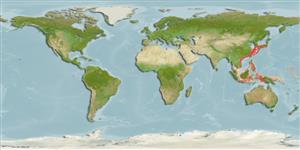Elasmobranchii (sharks and rays) >
Carcharhiniformes (Ground sharks) >
Proscylliidae (Finback catsharks)
Etymology: Proscyllium: pro (L.), in front of, probably referring to far forward placement of dorsal fin compared with Scyllium (=Scyliorhinus, Scyliorhinidae) (See ETYFish); habereri: In honor of German physician, anthropologist and natural history collector Karl Albert Haberer (1864-1941), who collected holotype (See ETYFish).
Eponymy: Dr Karl Albert Haberer (1864–1941) was an independent German anthropologist, naturalist, student of politics, and collector in Japan and China. [...] (Ref. 128868), visit book page.
More on author: Hilgendorf.
Environment: milieu / climate zone / depth range / distribution range
Ecology
Marine; demersal; depth range 50 - 100 m (Ref. 244). Tropical; 39°N - 8°S
Western Pacific: southeastern Japan to Viet Nam and northwestern Java, Indonesia (Ref. 13566).
Size / Weight / Age
Maturity: Lm ? range ? - ? cm
Max length : 57.0 cm TL male/unsexed; (Ref. 244); 65.0 cm TL (female)
Dorsal spines (total): 0; Anal spines: 0. Caudal fin without a rippled dorsal margin and ventral lobe but with a strong subterminal notch; vertebral axis of caudal fin little raised above body axis (Ref. 13566). Round dark brown spots and indistinct saddles (Ref. 13566).
A little-known, uncommon bottom-dwelling shark found on the shelves of continental and insular waters (Ref. 244). Dwell on the sublittoral zone, 50-320 m (Ref. 11230). Food habits little known; probably feeding on bony fishes, crustaceans and cephalopods (Ref. 244). Oviparous (Ref. 50449), with 1 to 2 pups in a litter (Ref. 244).
Life cycle and mating behavior
Maturity | Reproduction | Spawning | Eggs | Fecundity | Larvae
Oviparous, with a single egg deposited per uterus (Ref. 244). Embryos feed solely on yolk (Ref. 50449).
Compagno, L.J.V., 1984. FAO Species Catalogue. Vol. 4. Sharks of the world. An annotated and illustrated catalogue of shark species known to date. Part 2 - Carcharhiniformes. FAO Fish. Synop. 125(4/2):251-655. Rome: FAO. (Ref. 244)
IUCN Red List Status (Ref. 130435: Version 2024-2)
Human uses
Fisheries: subsistence fisheries
Tools
Special reports
Download XML
Internet sources
Estimates based on models
Preferred temperature (Ref.
123201): 17.4 - 28, mean 25.1 °C (based on 134 cells).
Phylogenetic diversity index (Ref.
82804): PD
50 = 0.6328 [Uniqueness, from 0.5 = low to 2.0 = high].
Bayesian length-weight: a=0.00288 (0.00112 - 0.00741), b=3.15 (2.92 - 3.38), in cm total length, based on LWR estimates for this (Sub)family-body shape (Ref.
93245).
Trophic level (Ref.
69278): 4.1 ±0.57 se; based on food items.
Resilience (Ref.
120179): Very Low, minimum population doubling time more than 14 years (Fec = 1-2).
Fishing Vulnerability (Ref.
59153): Moderate to high vulnerability (46 of 100).
